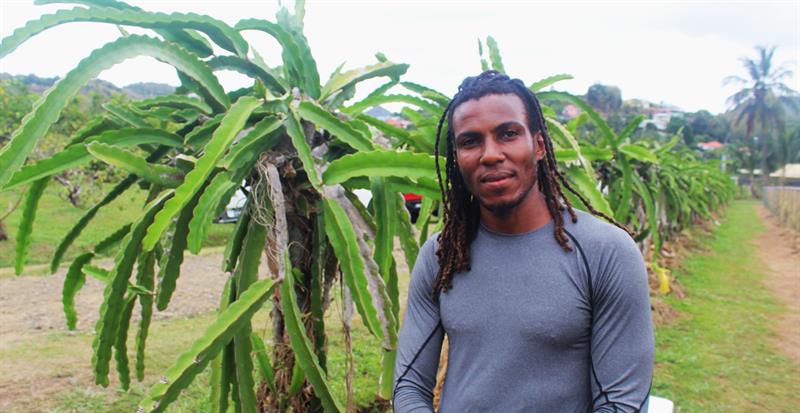THE SESSIONS PROVIDED GUIDANCE ON THE CULTIVATION, CARE AND HARVESTING OF DRAGON FRUIT.
 Farmers and extension officers from across Saint Lucia benefited from an important demonstration on how to cultivate dragon fruit. The activity was organized the Taiwan Technical Mission (TTM).
Farmers and extension officers from across Saint Lucia benefited from an important demonstration on how to cultivate dragon fruit. The activity was organized the Taiwan Technical Mission (TTM).
The 90-minute demonstration was held at the Union Demonstration Farm on the morning of Wednesday, April 23, 2025, where officials from the Taiwan Technical Mission shared insightful information on how to better cultivate, care for, and harvest dragon fruit. The demonstration formed part of activities under the “Enhancement of the Efficiency of Production-Distribution Supply Chain in Fruit and Vegetable Sector Project”, commonly known as the “Seven Crops Project”. The first phase of the Project began in January 2019 and lasted for three years, while the second phase runs from January 1, 2022 to December 31, 2026.
Mr. Edward Wilson, Technical Production Officer for the Seven Crops Project, said last Wednesday’s activity was in response to previous meetings and collaborations with other stakeholders, who agreed that there was a need for intervention in the cultivation of dragon fruit on the island.
“Primarily, the initial capital cost to set up a dragon fruit farm is very expensive, especially the concrete poles,” Wilson explained. “Secondly, when we were advocating for farmers to have bigger farms of dragon fruit, they were mulling the idea of putting concrete poles into their arable land that could be used for vegetable production. So Mr. Johnson Yang, the Production Specialist from the Taiwan Technical Mission, and I came up with a new set-up that replaces the need for the concrete poles.”
The new infrastructural set-up involves the use of galvanized pipes and special spring clips which lock the pipes into place to offer support for the mature plants, which are usually heavy in weight. The set-up also includes bamboo strips along which the young plants grow.
During the demonstration, farmers and extension officers learned how to use the spring clips and what lengths and dimensions to use for the set-up, appropriate planting distances, and how to plant and care for dragon fruit.
Using the galvanized pipes set-up, farmers can almost double their production. Wilson said the new set-up is cheaper and more conducive for the environment, and also easy to dismantle and set up elsewhere.
“The Taiwan Technical Mission is willing to provide assistance to farmers in the provision of spring clips, which we will be importing,” Wilson assured. “Whenever we demonstrate a certain farming practice, we always try to follow that up with readily available inputs.”
Mr. Johnson Yang, Senior Specialist for the Seven Crops Project, who has extensive experience in dragon fruit production, said farmers can reap lucrative rewards from cultivating the nutritious fruit.
“Planting dragon fruit is very rewarding for farmers because it’s very expensive. One kilogramme of dragon fruit costs $35.00. The plant is easy to grow and can be cultivated in backyards and home gardens,” Yang said.
Mr. Marakaiah Auguste, Extension Officer for Region 5 (Beausejour, Vieux Fort), was among the participants in the demonstration. He said the exercise was very important as the Ministry of Agriculture tries to encourage diversity in the Saint Lucian market.
“One of the ways to do so is by encouraging farmers to become involved in dragon fruit production because we know there is a market for it right here,” he said. “So if the farmers can diversify into dragon fruit production, that can help sustain livelihoods.”
Auguste noted that while some farmers in his region are already cultivating dragon fruit, the farm demonstration last Wednesday provided some new insights into making production not only easier, but also more bountiful.
Meanwhile, Mr. Jamal Alexander, a farmer from Balata, who operates two farms at Balata and La Perle, Dennery, commended the Taiwan Technical Mission for its continued efforts to educate farmers. He’s been engaged in farming part-time for five years now, and recently quit his hotel job to farm full-time. His farms consist of watermelons, cantaloupes, honeydew, okra, pineapple, and corn. He recently introduced dragon fruit to his farms.
“Dragon fruit is something I’ve been interested in for a while now,” Alexander said. “I saw the techniques they used before, but was trying to implement my own techniques, which I figured worked better for me. The demonstration explained how I can use an even better system to realize greater production. There’s a lot of money in dragon fruit production because it’s one of the most expensive fruits. So the more dragon fruits you have, the more money you will get.”
Dragon fruit is cactus plant native to Central and South America, and looks like a large cactus pear. Red dragon fruit is usually bright pink, while yellow dragon fruit is bright yellow. Dragon fruit tastes like a cross between a pear and kiwi, and has a kiwi-like soft texture when ripe. The fruit contains antioxidants such as Vitamin C, which can help fight free radicals, and help promote healthy, glowing skin.
Read more: https://www.govt.lc/news/taiwan-technical-mission-hosts-dragon-fruit-demonstration
Watch via YouTube: https://www.youtube.com/watch?v=RGy5JfEvfdQ
Listen to podcast: https://pod.co/government-of-saint-lucia/dragon-fruit-training-ttm